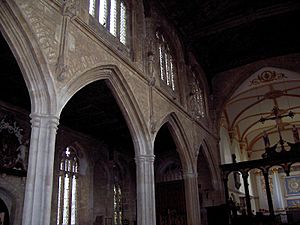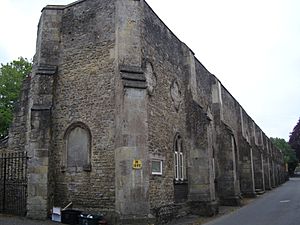Bruton Abbey facts for kids


Bruton Abbey was a special religious house in Bruton, Somerset, England. It started around 1127 as a home for Augustinian canons, who were like priests living together under a set of rules. Later, in 1511, it became an abbey, which is a larger and more important monastery. However, it was closed down not long after, in 1539. The abbey was given lots of land, churches, and other properties nearby and even in France to help support it.
A Look Back in Time
Some old records suggest that Bruton might have had a Benedictine monastery as early as 1005. However, it's more certain that the Augustinian priory (a smaller type of monastery) was founded around 1127.
Over time, the priory made some changes to its land. In 1260, it traded its properties in France for land in Sussex and Gloucestershire.
During the 1400s, the priory faced some challenges. For example, in 1419, a leader named John Schoyle became prior. There were difficulties, and he was later sent to live at another monastery. His replacement, Richard of Glastonbury, also had problems, and investigations were held into how the monastery was being run. Later, a new prior introduced stricter rules. These rules made sure the canons stayed at the monastery, didn't go hunting or play dice, and kept women out of the monastery.
Bruton Priory became a full abbey in 1511. But even then, it continued to face difficulties. The abbot, Ely, had a tough time, and the abbey was eventually closed down in 1539. This was part of a bigger event in England called the Dissolution of the Monasteries, when many monasteries were closed by the king.
The Bruton Dovecote
The Dovecote is a historic building that stands on a hill overlooking Bruton. It was built in the 1500s. Over the years, it has been used for different things, possibly as a house, a watchtower, and a place to keep pigeons. Today, it is managed by the National Trust and is a protected historic site. This building was once part of the abbey's deer park. Around 1780, it was changed to become a dovecote, and it has more than 200 pigeon holes inside.
What Happened After the Abbey Closed?
After Bruton Abbey was closed, its land was given to a man named John Drew. Later, it was given to Sir Maurice Berkeley, who was an important person in the royal family. Sir Maurice built a new house on the abbey site, using some of the old abbey buildings. However, this house was later taken down in 1786.
Sir Maurice Berkeley's impressive tomb can still be seen in the local church. His family, the Berkeley family of Bruton, became very well-known.
The main church in the town, the Church of St Mary, Bruton, is very old. It was built mostly in the 1300s and 1400s. Even though it was technically part of the abbey grounds, it has always served as the main church for the people of Bruton. There was a church on this spot even before the abbey was founded. A unique part of the church is its chancel (the area near the altar), which was rebuilt in 1743 in a bright and airy Rococo style. This looks quite different from the older, medieval parts of the church.


